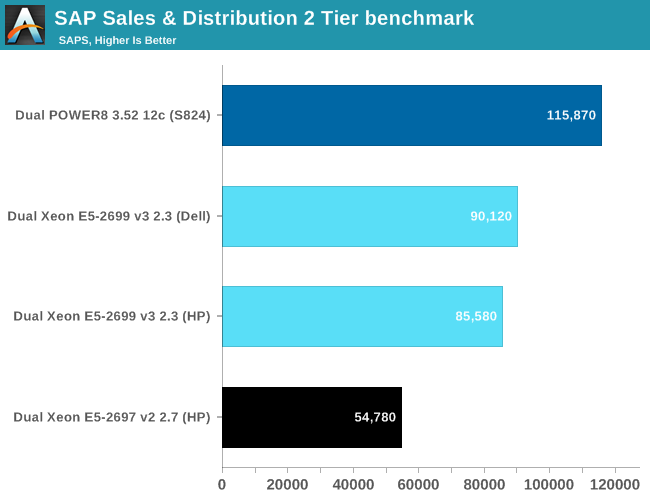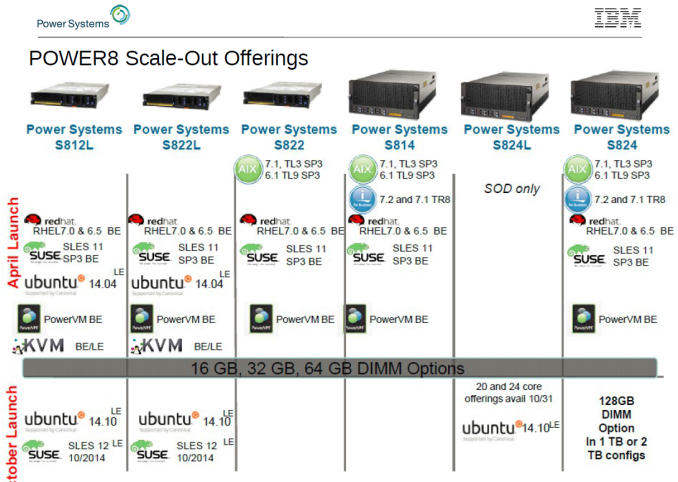The IBM POWER8 Review: Challenging the Intel Xeon
by Johan De Gelas on November 6, 2015 8:00 AM EST- Posted in
- IT Computing
- CPUs
- Enterprise
- Enterprise CPUs
- IBM
- POWER
- POWER8
Reading the Benchmarks
There are a lot of benchmarks available that compare the IBM POWER8 to Xeons. One example is the Enterprise Resource Planning (ERP) software SAP. We have used the Sales & Distribution 2 Tier benchmark many times because it is one of the very few benchmarks that is a very good representation of real world high-end enterprise workloads.

Now combine this with the benchmarks that IBM has compiled on their marketing slides and the fact that we know that the POWER8 chip has a TDP of 190W at nominal speed and 247W when running at "Turbo" clockspeeds.
It all seems very simple: the IBM POWER8 is a more power hungry chip but delivers much better performance. But as always you should take the time to read the benchmarks very closely. The IBM S824 is typically the one featured in the benchmarks. However, we are pretty sure that is not the system that will be able to sway the current Intel Xeon customers towards OpenPOWER. Nor are we convinced that the most widely reported benchmarks are accurately predicting the experience of those people.
There are three reasons for that. First of all, most of the benchmarks are run on AIX (7), IBM's own proprietary UNIX. AIX is a high performance, extremely robust OS, but it does not have the rich software system and support that Linux has. Furthermore even with their common design elements, an excellent Linux administrator will have to invest some time to get the same level of expertise in AIX. But more importantly, the S824 is a pretty expensive machine, both in acquisition cost (starting at $21.000, up to $60.000 and more) and energy cost. That kind of pricing lands the system in hostile and more powerful quad Xeon E7 territory.
Lastly, the S824 uses two CPU cards or Dual Chip Modules (DCM), each containing two six-core POWER8 modules at 3.5 GHz. Now consider that the third party OpenPOWER servers have 190/247W TDP 10-core 3.4 GHz POWER8 CPUs. The power consumption does not increase linearly as you add more cores and higher clocks. So the CPU modules found inside the S824 are definitely more power hungry, probably well above 250W.
There is more. Take a look at IBM "Scale-out" server, the more affordable server range of IBM servers. First, a bit of IBM server nomenclature which is actually quite logical and easy to decipher (take note, Intel marketing).
- S stands for "Scale-out"
- 8 stands for POWER8
- 1 or 2 is the number of sockets
- 2 or 4 is the height, expressed in rack Us.
So an S824 contains 2 sockets in a 4U chassis and a S812 is a one socket system. There is one designation left, : the "L" or Linux .
Notice that the non-L versions also support Linux, but a few months ago they supported only the Big Endian (BE) versions (the slide is from the beginning of this year). IBM told us that all POWER8 servers now support both Little Endian (LE) and BE Linux.
This is important since using an LE version (Ubuntu, SUSE) makes data migration from and data sharing (NAS, SAN) with an x86 system much easier, as x86 only supports LE.












146 Comments
View All Comments
Mondozai - Friday, November 6, 2015 - link
That's too bad. Over 90% of the world population exists outside of it and even if you look at the HPC market, the vast majority of that is, too.The world doesn't revolve around you. Get out of your bubble.
bji - Friday, November 6, 2015 - link
He never claimed the world revolved around him, he just made a true statement that may be worth consideration. Your response is unnecessarily hostile and annoying.I would expand Jtaylor1986's statement: I believe that most if not all native English speaking populations use commas for thousands grouping in numbers. Since this site is written in English, it might be worthwhile to stick to conventions of native English speakers.
It's possible that there are many more non-native English speakers reading this site who would prefer dots instead of commas, but I doubt it. Only the site maintainers would know though.
Jtaylor1986 - Friday, November 6, 2015 - link
You read my mind :)mapesdhs - Tuesday, November 10, 2015 - link
Talking to numerous people around Europe about tech stuff, I can't think of any nation from which someone used the decimal point in their emails instead of a comma in this context. I'd assumed the comma was standard for thousands groupings. So which non-US countries do use the point instead? Anyone know?lmcd - Friday, November 6, 2015 - link
Cool on the rest of the world part, but the period vs comma as delimiters in the world numeric system ARE backward. In language (universal, or nearly), a comma is used to denote a pause or minor break, and a period is used to denote the end of a complete thought or section. Applied to numerics, and you end up with the American way of doing it.^my take
JohanAnandtech - Saturday, November 7, 2015 - link
Just for the record, this was not an attempt to nag the US people. Just the mighty force of habit.ZeDestructor - Saturday, November 7, 2015 - link
For future use: just use a space for thousands seperation (that's how I do it on anything that isn't limited to a 7seg-style display), and confuse readers by mixing commas and periods for decimals :Ptygrus - Sunday, November 8, 2015 - link
I like to use a fullstop for the decimal point, an apostrophe for the thousands separator, a comma for separating items in the list, don't start a sentance with a digit.One list of numbers may be : 3'500'000, 45.08, 12'500.8, 9'500. Second list : 45'000, 15'000, 25'000. We use apostrophes when we contract words like don't so why not use it for contracting numbers where we would otherwise have the words thousand, millions, billions etc ?
mapesdhs - Tuesday, November 10, 2015 - link
I have a headache in my eyeballs! :Dws3 - Friday, November 6, 2015 - link
North America is on the majority side on this issue. Asia, in particular, is almost completely on the side of using a dot as the decimal separator and a comma to put breaks in long numbers.Get with the program Europe. The world doesn't revolve around you!